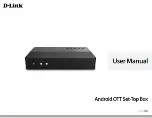
20
Picture Formats
What Is the Difference Between a Standard-Screen and a Wide-Screen
HDTV?
The type of screen your HDTV has (wide-screen or standard-screen) determines how the set-top box
displays programs on the screen. The picture format for an HDTV is a combination of
aspect ratio
and
screen resolution
and is different for standard-screen and wide-screen HDTVs.
What Is Aspect Ratio?
An aspect ratio is the ratio of the width to the height of the TV screen. The aspect ratios differ because
the television industry manufactures both standard-screen and wide-screen HDTVs to appeal to consumer
viewing preferences.
What Is the Screen Resolution?
The screen resolution indicates the amount of detail that the picture displays. Resolution is identified by
the number of display lines on the screen. The techniques that an HDTV uses to “paint” the picture on the
screen are referred to as progressive and interlaced.
With the
progressive scanning
method, the lines are drawn on the screen one at a time in sequential
order. Progressive scanning results in a more detailed image on the screen and is also less susceptible to the
flicker commonly associated with interlaced scanning. The
interlaced method
involves refreshing pixels in
alternation — first the odd lines and then the even lines.
For advanced setup, select the screen resolution that your TV can support. See your HDTV user manuals
to choose the proper screen resolution (480i, 576i, 720p, 1080i, or 1080p) for your setup.
For example, a screen resolution of 1080i indicates that the screen shows 1080 lines in an interlaced display,
and 720p indicates that the screens shows 720 lines in a progressive display.
A
standard-screen SDTV
has a 4x3
aspect ratio. The screen is 4 units wide for
every 3 units tall.
A
wide-screen HDTV
is one-third wider than
a standard-screen HDTV. The screen is 16 units
wide for every 9 units tall.
A screen resolution of 480i or 516i fills
the screen.
A screen resolution of 720p or 1080i fills
the screen.
9
16
4
3
TECHNICOLOR
1-5, rue Jeanne d’Arc
92130 Issy-les-Moulineaux
France
www.technicolor.com
Copyright 2016 Technicolor. All rights reserved.
All tradenames referenced are service marks,
trademarks, or registered trademarks of their respec-
tive companies. Specifications subject to change
without notice.
DMS3-CTC-25-XXX v1.0
Trademark and License Information
Rovi Disclaimer
Technicolor will not be responsible for any licensing fees payable to Rovi Corporation, and Technicolor
will not have any indemnification obligations relating to any claims asserted by Rovi Corporation, or by
any entity controlled by, controlling, or under common control with Rovi Corporation (“Rovi Entities”),
or any entity used to license intellectual property of the Rovi Entities, and the successors and assigns of
the foregoing entities, including any claim related to electronic programming guides alone or in
combination with any equipment provided by Technicolor.
Dolby
Manufactured under license from Dolby Laboratories. Dolby, Dolby Audio and the double-D symbol
are trademarks of Dolby Laboratories.
HDMI
The terms HDMI and HDMI High-Definition Multimedia Interface, and the HDMI Logo are
trademarks or registered trademarks of HDMI Licensing LLC in the United States and other countries.




































